Category Archive for Fims + Videos
Oakland Cat Town Cafe, first to open in USA! ABC Nightline TV interview, Shinjuku Tokyo Robot restaurant.
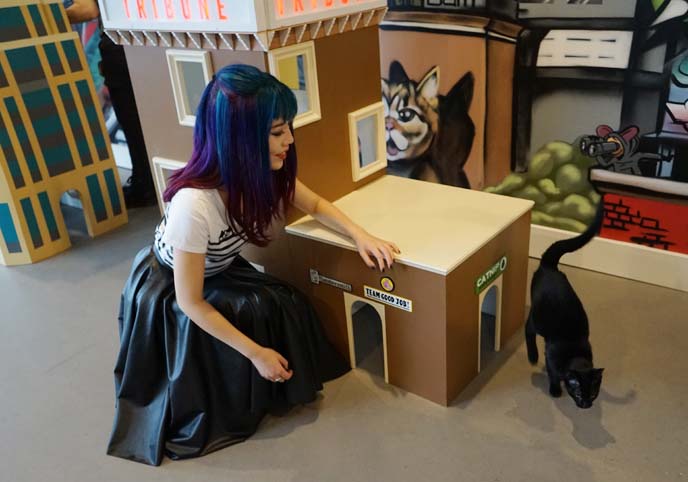
So many maooos! Last December, I was honored to be interviewed on ABC Nightline, the long-running news program that is broadcast worldwide. The network flew me to San Francisco to be interviewed in a segment about cat cafes and the spread of J-pop culture to America.
If you missed this ABC Nightline episode, don’t fret — you can watch it below and on my YouTube channel. It includes footage of the psychedelic Robot Restaurant in Shinjuku, bikini-clad fembots and kawaii maid cafes!
The TV crew and I filmed at the first cat cafe to open in the USA: Cat Town Oakland (near San Francisco). Unlike Japanese kitty cafes, this one has a meaningful mission: to save at-risk abandoned felines.
Want to peek inside Cat Town and a J-pop mall in San Francisco? Then read on.
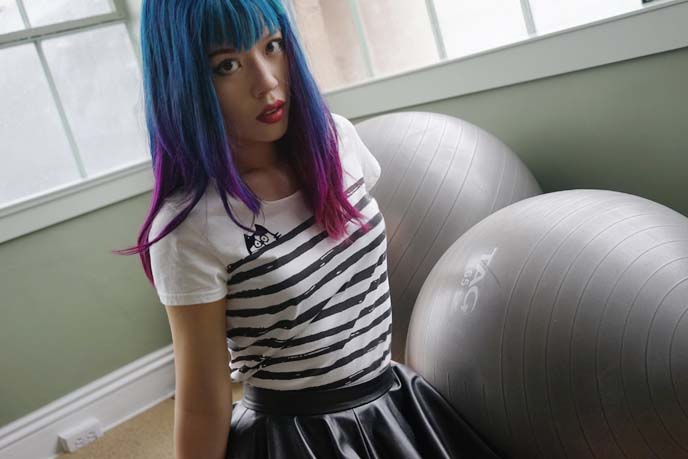
First, details of what I wore on my TV appearance. There’s a mao-mao peeking out from my striped top! It’s actually a dress by Mandycat in Hong Kong. (Here’s a similar striped top with a bat on it.)
Click the items below, to build an outfit like mine!
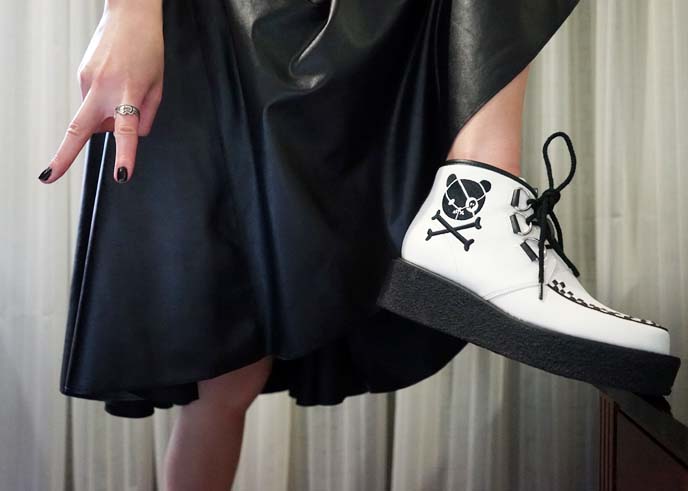
My long, leather skirt is by the young Hong Kong-based designer, Erbert Chong. Everyone is raving about his leather, edgy yet wearable designs for women. I can’t get over the materials and finish of his pieces — they’re some of my favorite items in my wardrobe right now.
My white creeper shoes, with a pirate bear, are Peace Now. This Japanese brand has unfortunately shut down…
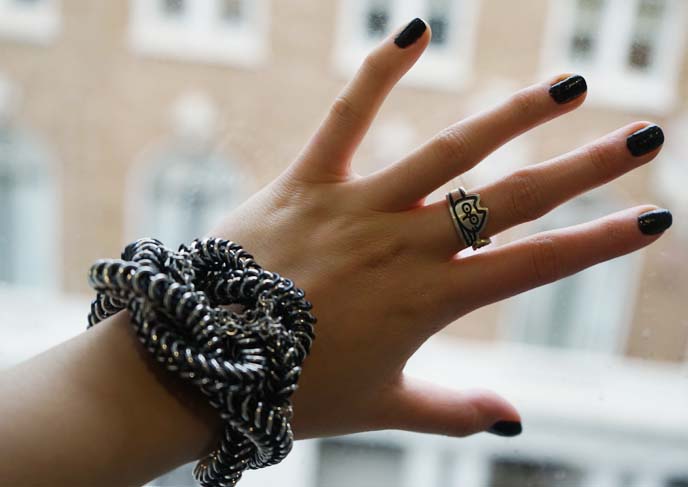
My coiled, silver 3D bracelet is from Angelica Brigade.
Everyone should have a cat ring, in my opinion! Here’s where you can get a cat-faced ring like mine.
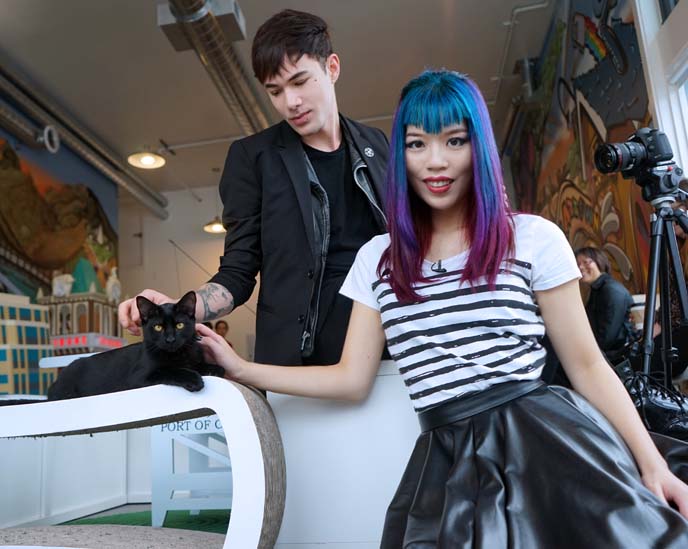
Trevor joined me for the ABC Nightline TV news shoot at Cat Town (address: 2869 Broadway in downtown Oakland, California). Not a bad job, playing on-camera with a dozen kitties. (Watch the video here).
Like the Shinjuku cat cafe, the space is creatively decorated with all sorts of climbing platforms and toys.
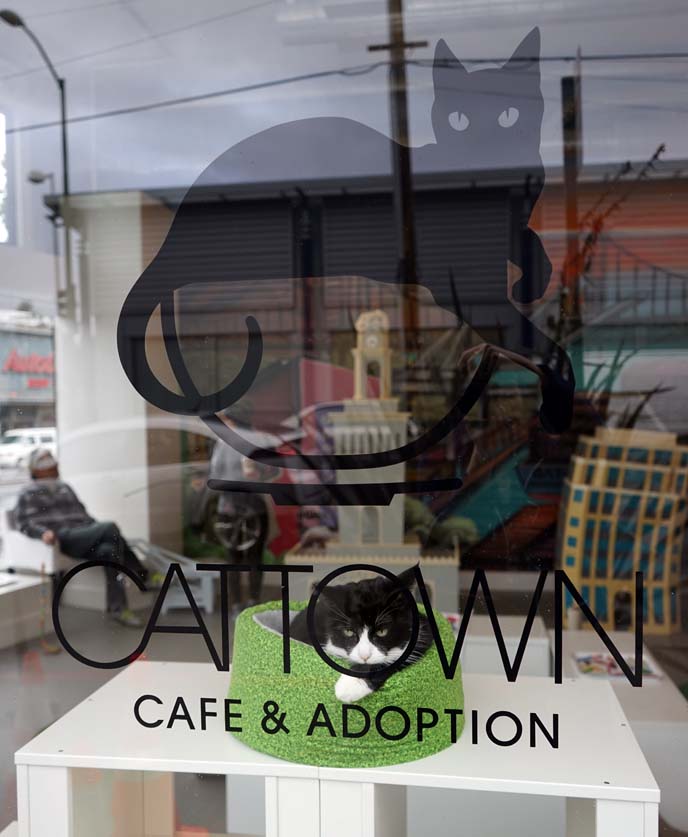
Japanese cat cafes — cute as the concept is — tend to operate a bit like petting zoos. These cafes bring in rare purebred species, like exotic shorthairs, for the customers to enjoy.
In contrast, Cat Town is a partnership with Oakland Animal Services. The cafe provides a stimulating environment for shelter cats, especially the ones who are the least likely to be adopted. Volunteers help to run the space, and the goal is to let these abandoned cats blossom and find permanent adoptive homes.
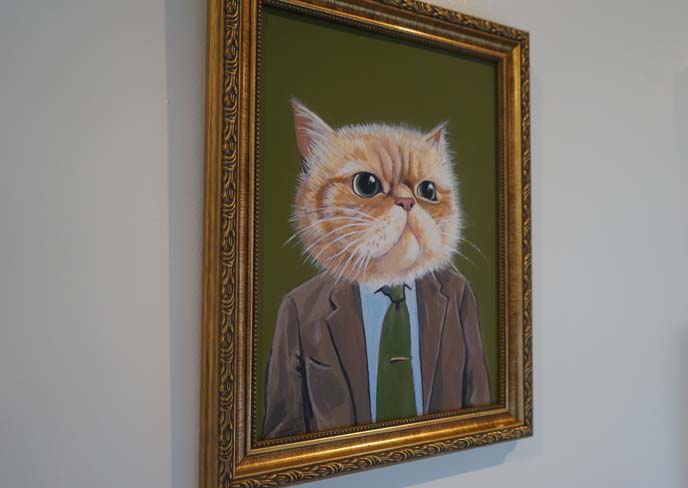
As soon as you step into Cat Town, you feel that the operation is full of heart. The humans who work here puts the needs of the cats first (and the decor reinforces their prime position!)
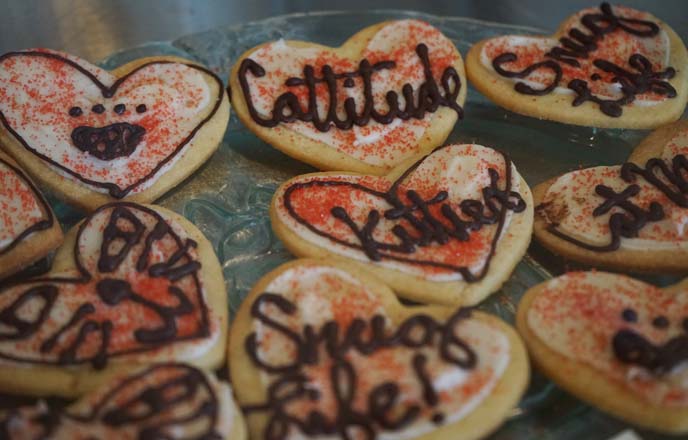
The coffee shop is separate from the cat-petting area, but you can bring your latte inside and sip it while playing with cats. The cafe focuses on supporting local businesses, and sells small-batch pastries from a local baker, like cookies laced with “Cattitude.”
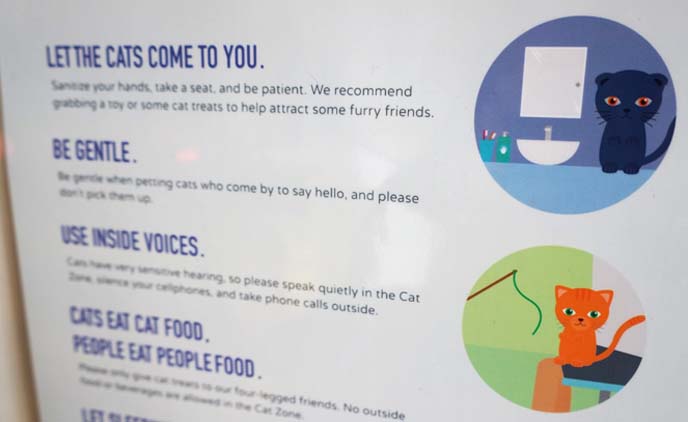
Like in the Tokyo cat cafes I visited, there are rules to follow, which keep the cats safe. However, unlike in Asia, guests don’t take off their shoes before entering, nor are they required to sanitize their hands.
(Do you see the Scottish Fold drawing in the top corner? It’s the only fold at the cafe, since this round-faced breed rarely ends up in animal rescues.)
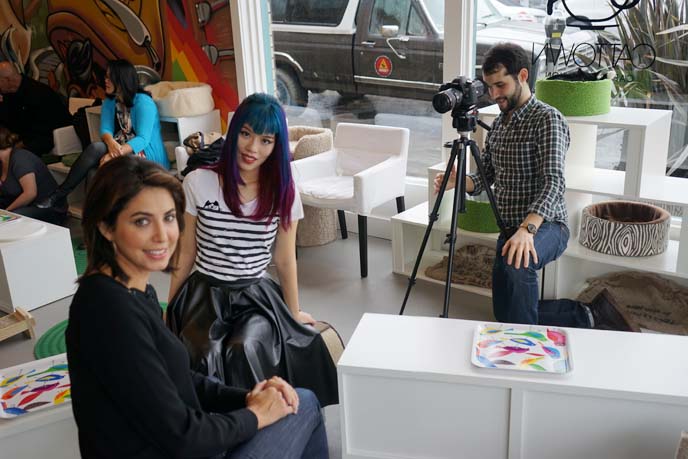
I’ve been chatting with ABC Nightline’s team for some time now, and gave them travel tips when they went to Tokyo. As a follow-up for their Tokyo pop culture stories, I appeared on the show to give background and context on maid, cat and robot cafes in Japan.
Here I am with ABC News presenter Cecilia Vega, and producer / director Nick Capote. They’re so sweet, and we had a fun day together!
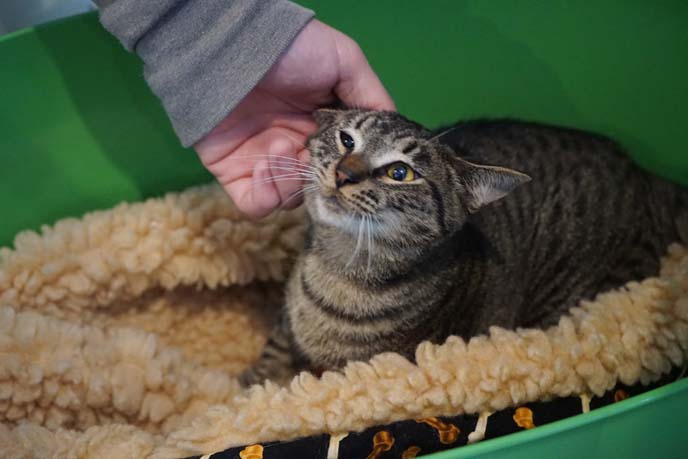
Cecilia and I wandered around Cat Town, and played with the cats. It’s great to see the strays thriving in this cat-tastic environment.
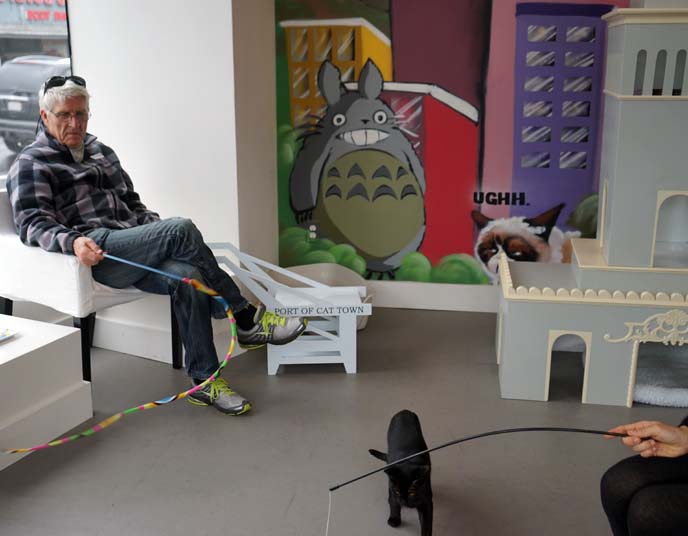
You can grab a cat toy, and they’ll pounce all over it. The walls are covered with colorful murals, including artwork of Grumpy Cat, Totoro, Nyan Cat and more pop culture icons.
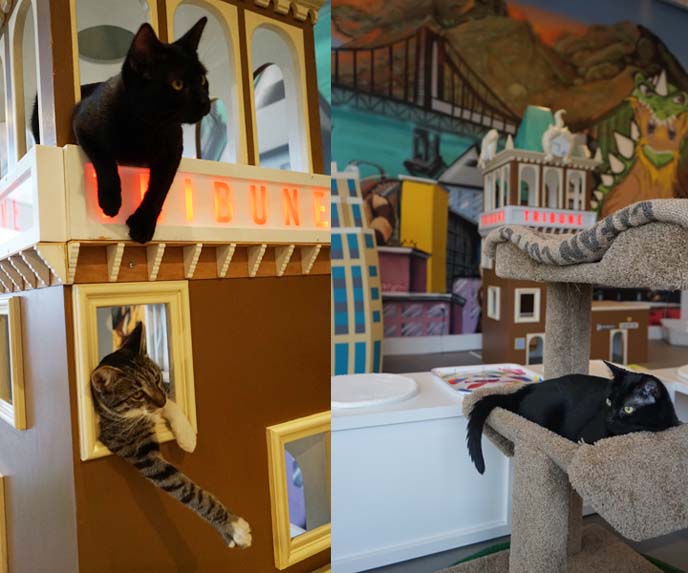
The custom-built playgrounds are a tip of the hat to San Francisco’s landmarks, like the Tribune building.
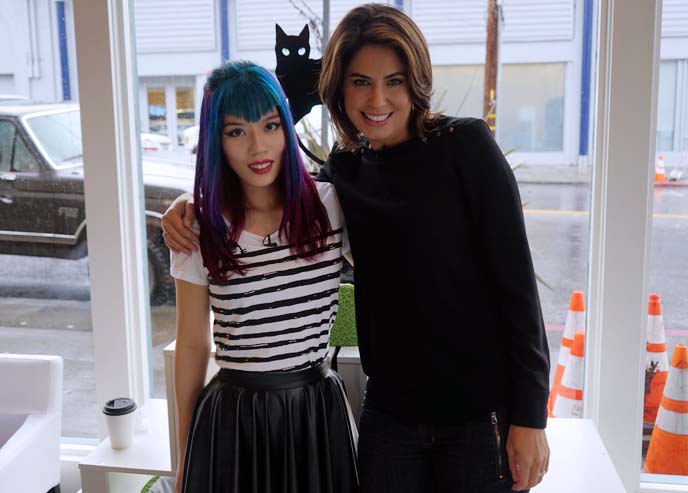
Cecilia Vega and I chatted about the appeal of cat cafes, the spread of Japanese concept cafes to North America, and more. Watch our conversation on the ABC Nightline segment.
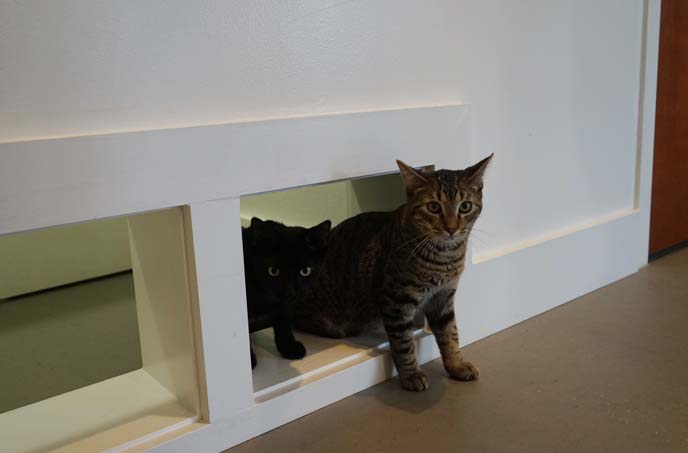
Peekaboo, I see you! The cats have a private room in the back where they can escape the crowds and sleep.
A few of the kitties couldn’t take their paws off our film equipment. Several took a nap in a camera bag.
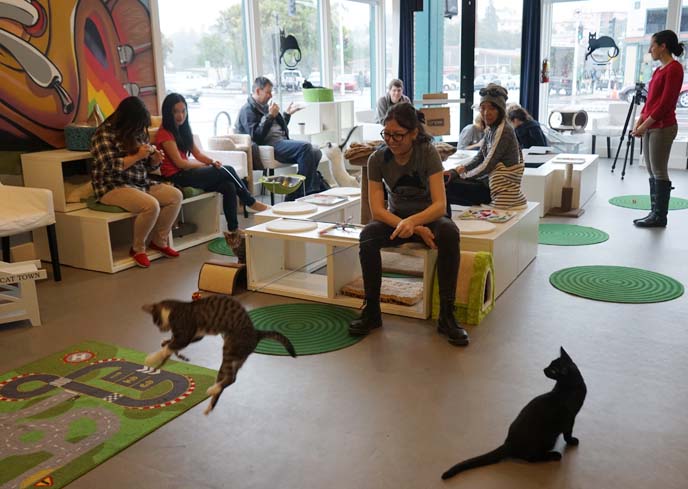
Rescuing and re-homing cats continue to be a challenge in cities worldwide. Animal shelters do great work, but are over-crowded and stressful.
So far, Cat Town is succeeding at giving them space to thrive.
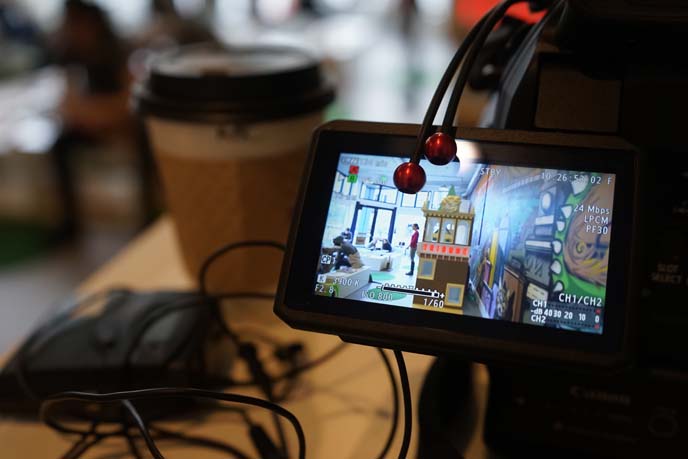
Already, adoption rates are up: customers will play with the cats and fall in love with one. All the adoptions go through a screening process, to make sure the pets go to secure homes.
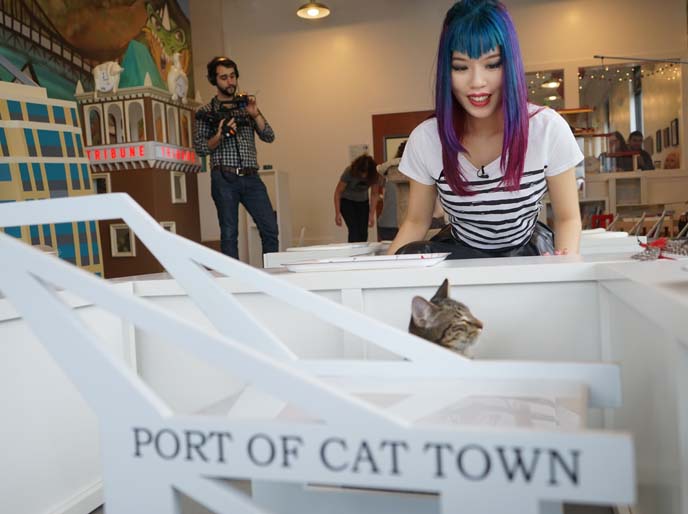
The volunteers genuinely care about the cats, and do the best for them. As an example, I noticed that they feed the kitties Wellness — a byproduct-free, grain-free brand that I feed my own Scottish Fold baby, Basil Farrow. The staff told me that they turned down sponsorship offers from big-name cat food companies, since this mass-produced food doesn’t contain the best ingredients for their health. Go Cat Town!
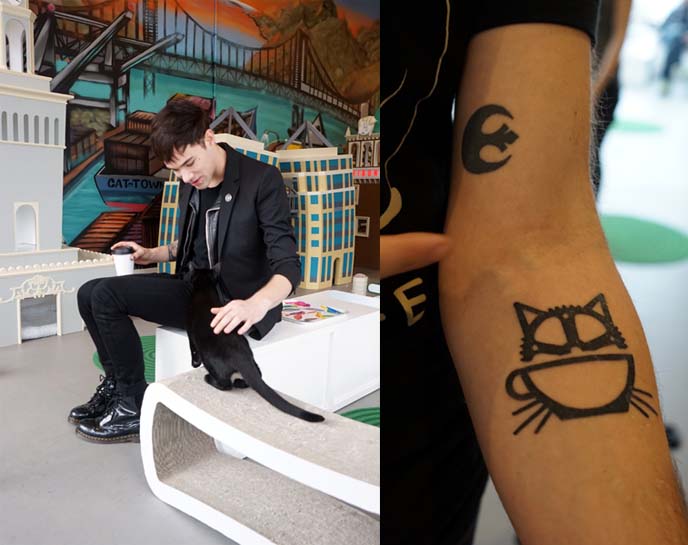
Another instance of dedication: co-founder Adam has a tattoo of their coffee partner’s logo (Bicycle Coffee), with cat-ears and whiskers. On the left, Trevor strokes a black cat, which matches his look.
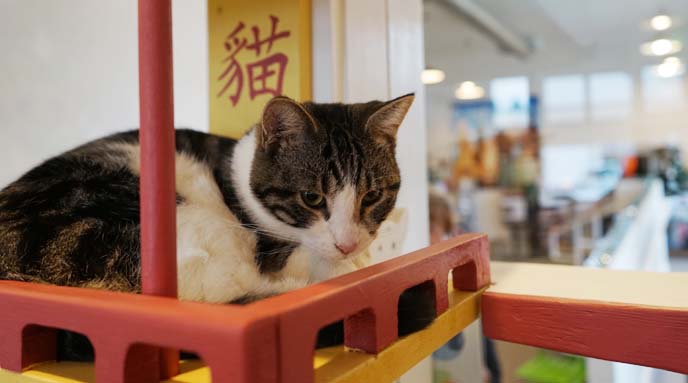
For these reasons, I’ve been recommending Cat Town to everyone who visits San Francisco. It’s the first cat cafe to open up in America, and hopefully sets the standard for a meaningful, adoption-oriented approach.
Entry is by donation; you can reserve a guaranteed visitation time with a minimum $10 donation. Every hour, about 20 people are allowed into the space, and you can play with about 10-15 felines.
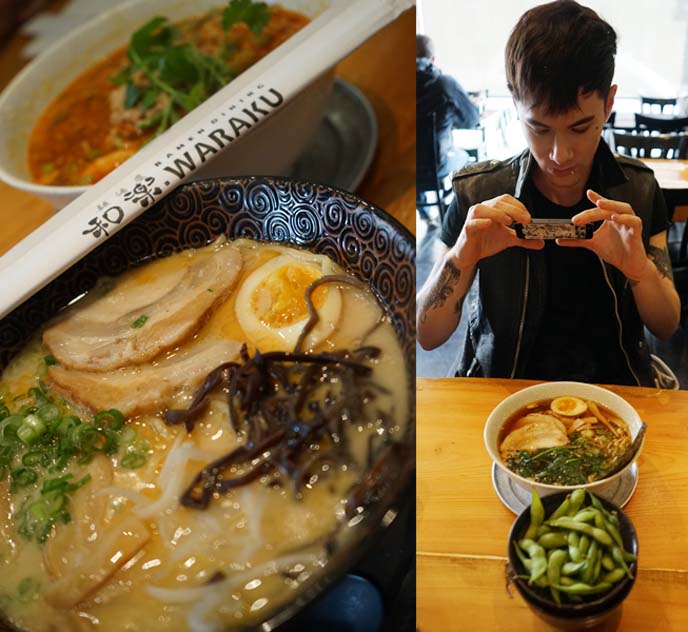
Trevor, the ABC team and I took a quick lunch break in SF’s Japan Town. I’m still thinking about the ramen at Waraku, it was that good!
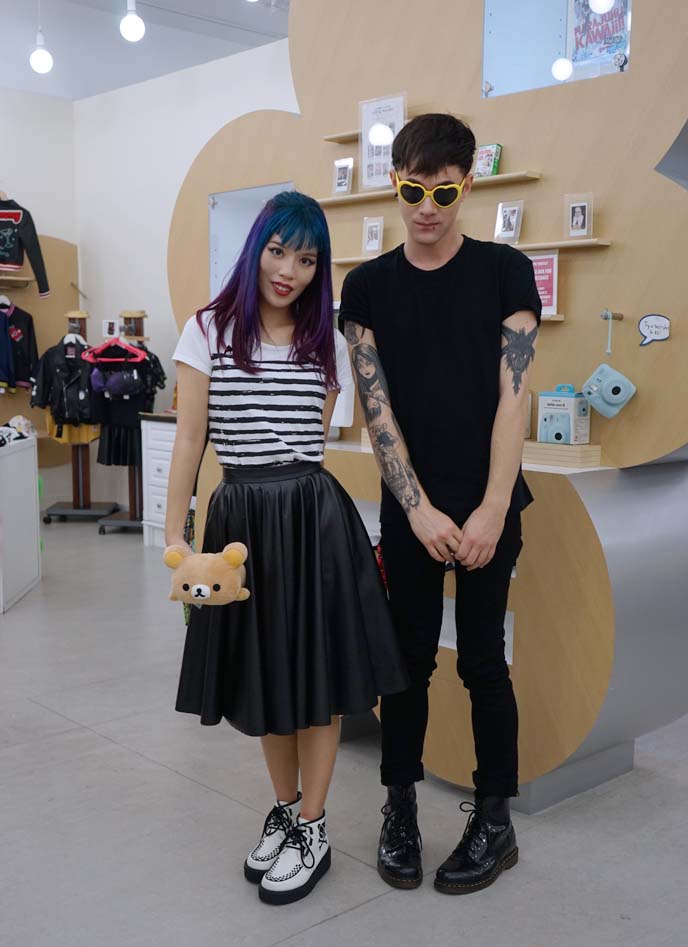
We continued filming for the episode at New People World, the Japanese fashion mall. (The address and a tour of the boutiques are in my San Francisco shopping guide.)
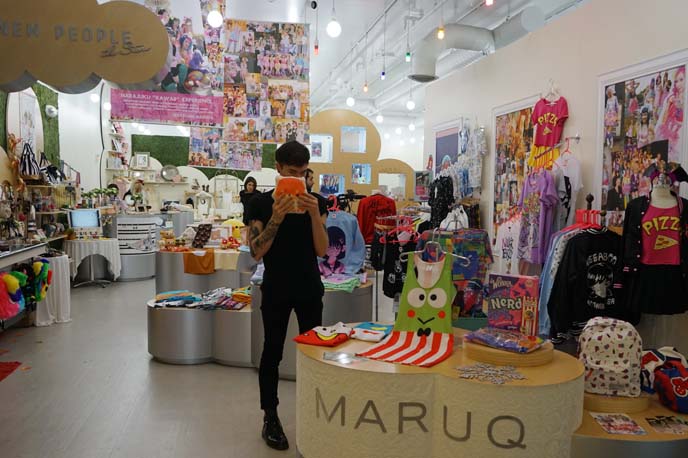
MaruQ, located on the first floor, remains my favorite store in the Jpop mall. So much cuteness in one room, including brands like Ayammy, Omocat and Liz Lisa.
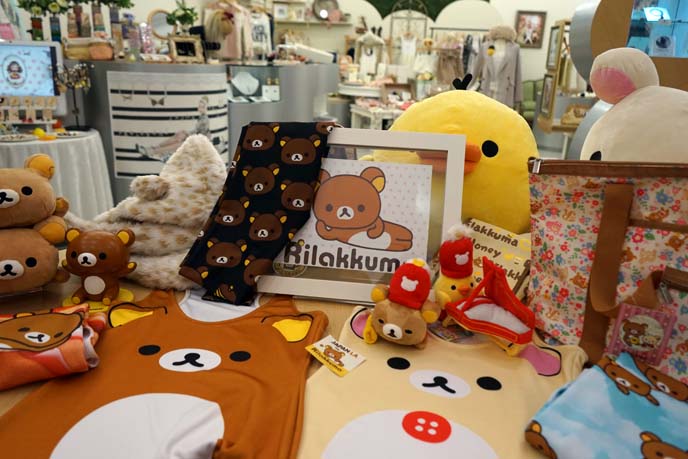
Raise your paw if you love Rilakkuma the bear! (Sadly, this segment was cut from the ABC Nightline feature, but I still wanted to share these images with you.)
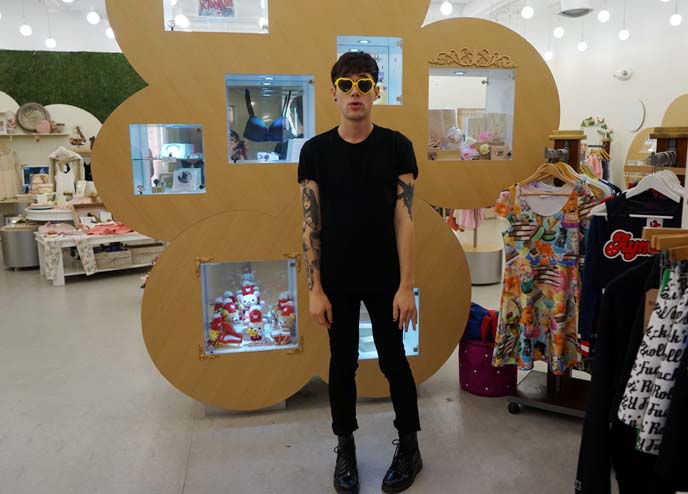
Cecilia and I walked around the store, and chatted about the growing popularity of Japanese street fashion in America. Can you spot Trevor in the background?
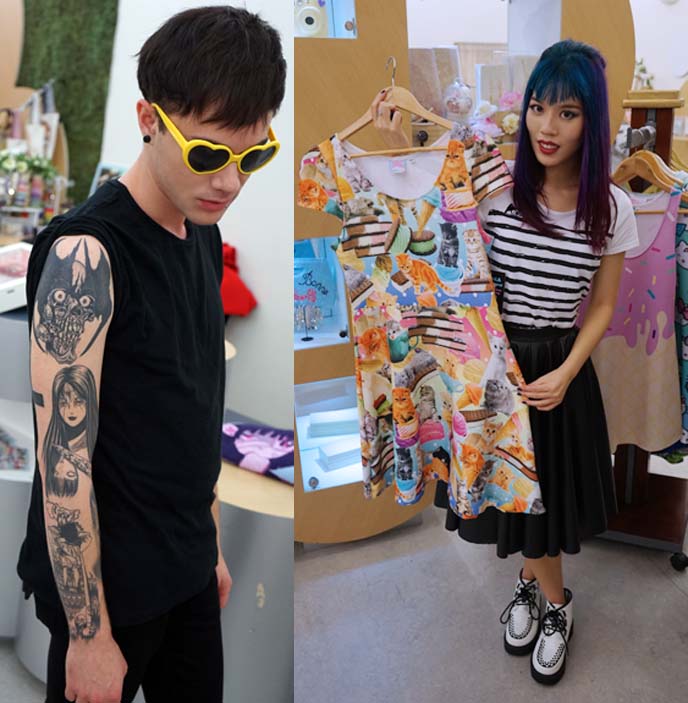
Gothic tattoos and a rainbow cat dress: spooky meets sweet, that’s how we roll.
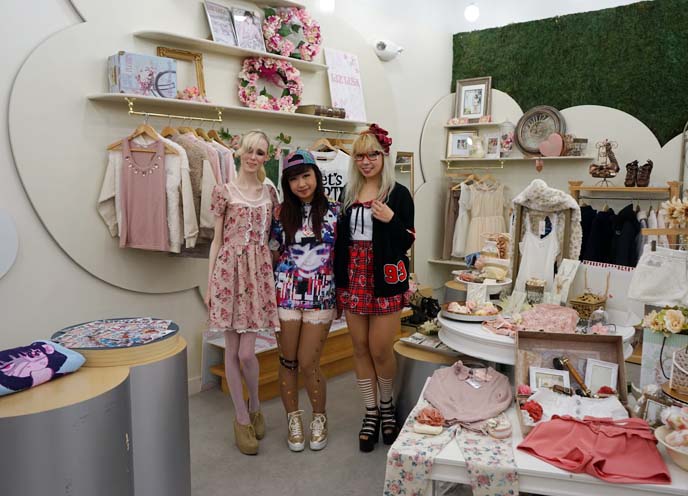
The shop girls are adorable as ever. They’re modeling a variety of looks from Japanese style tribes.
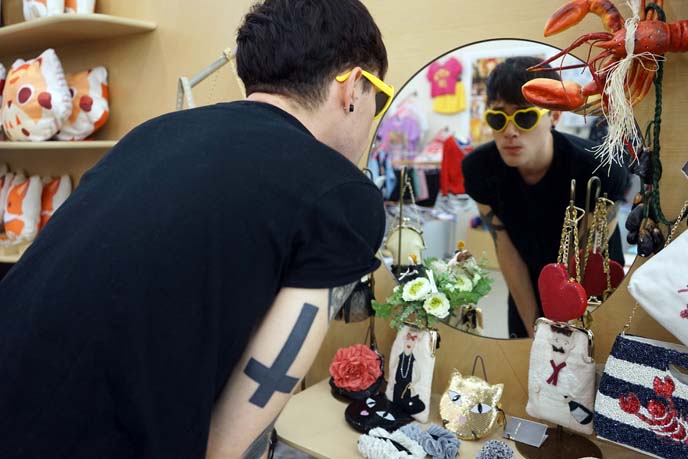
Trevor couldn’t resist getting these sunglasses. “And I won’t break your heart shaped glasses.”
For more info on where to get Goth, vintage, alternative and kawaii clothing, check out my San Fran shopping guide.
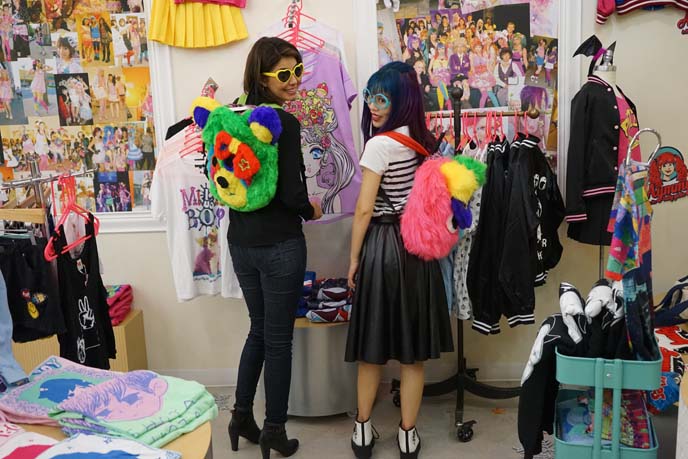
A million “arigatos” for the ABC Nightline team, for having me on the program!
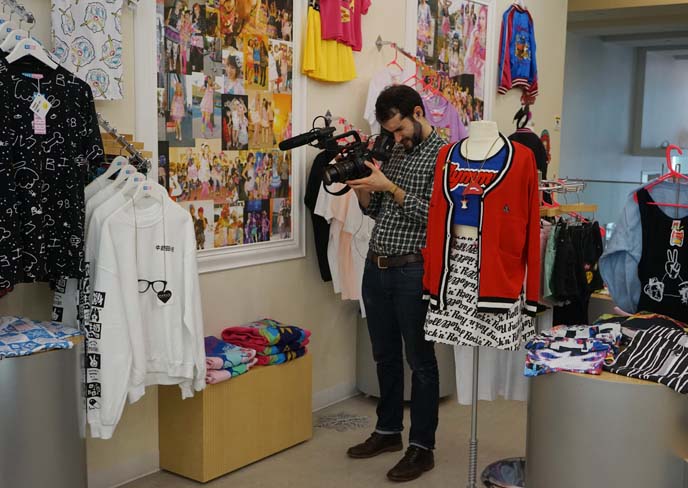
Please take a moment to watch my interview on ABC Nightline! The segment includes crazy footage from the Robot Restaurant in Japan (with robot-women performers), maid cafes, and cat cafes in Tokyo and California.
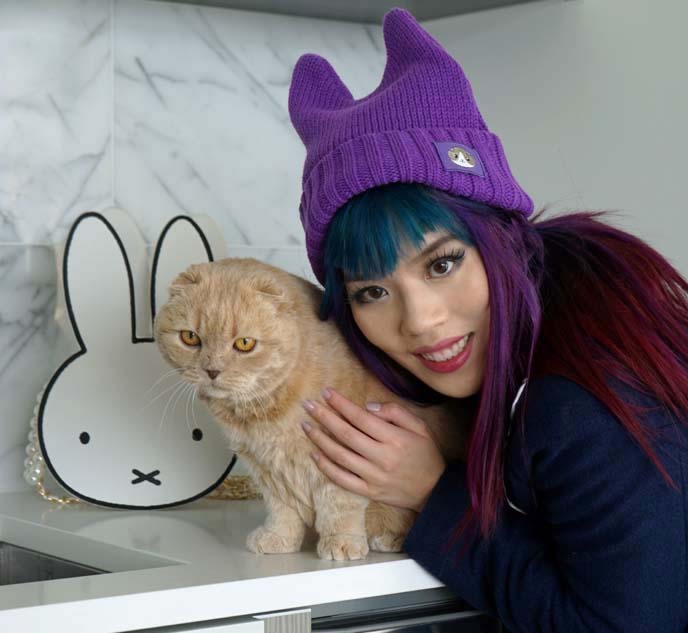
Have you ever been to a cat cafe? Would you want one to open in your hometown?
Shop my ABC TV outfit below…
SHARE & COMMENT
10 Things I Love about Cape Town: Wine, jazz, drag queens! South Africa travel show episode.

I’m leaping in the air because our Cape Town video is out!
In this latest episode of my travel show — published on Business Insider Travel — I encounter lions, drag queens, penguins…
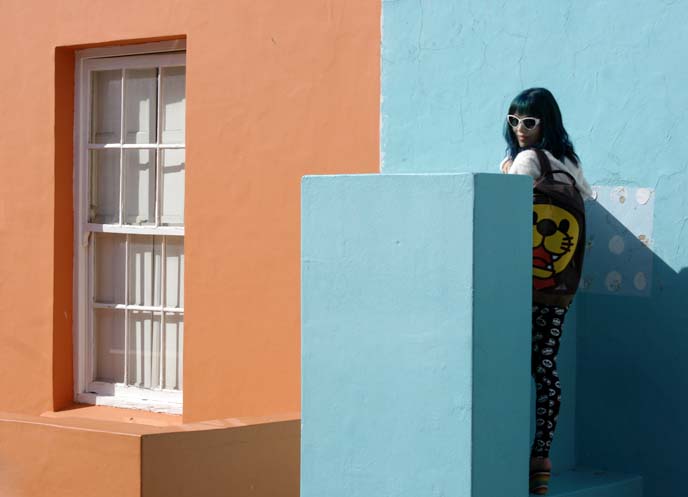
…street art, and color everywhere. (Above, I’m posing with the rainbow homes of the Bo-Kaap district – outfit details and more here.)
Please take a few minutes to watch our episode above and on Business Insider.
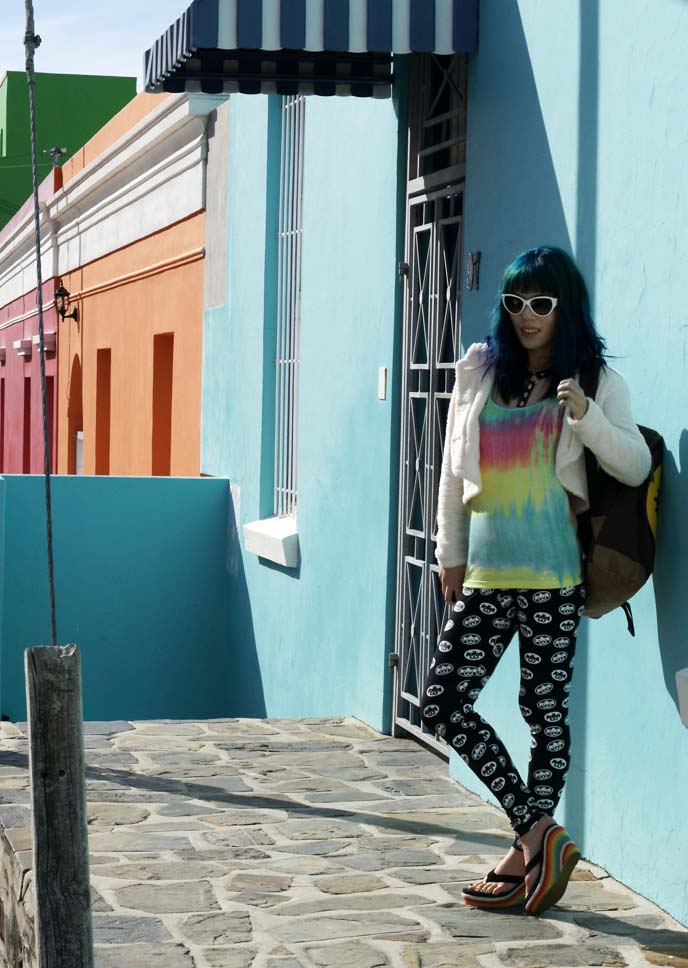
It was hard to edit all the fantastic footage into a short video. I could go on for hours about why I love this city — but I’ll boil it down to 10 things I love about Cape Town.
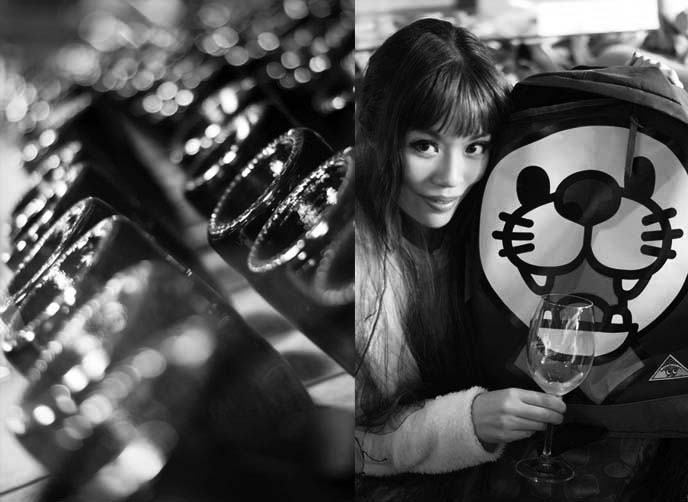
1. South African Wine Tastings
South Africa’s wines have been getting attention in recent years, especially those from the Stellenbosch region. I’m no wine expert, but I can tell you that these are some of the best I’ve tasted (and I’ve tasted a lot).
Our driver took us about an hour outside of Cape Town to Steenberg, a modern vineyard and farm. The staff poured us a selection of white and reds, including the smooth and complex Magna Carta. I wish I had a glass of it in my hand, as I’m typing this!
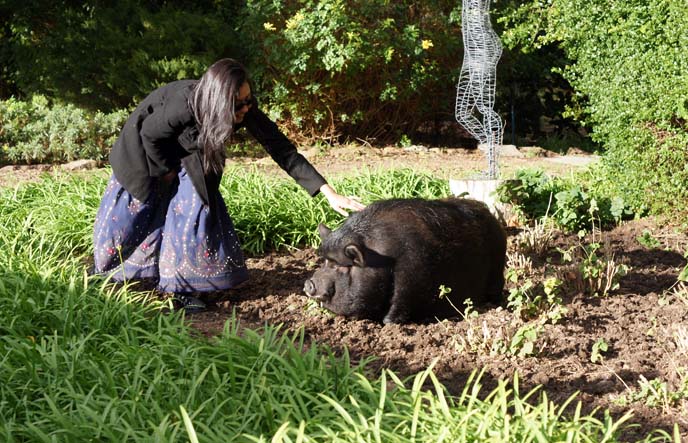
Outside, we ran into Pumbaa the warthog! This rotund creature really looks like the African pig in the Disney movie, The Lion King. Of course, filmmaker Melissa had to sing Hakuna Matata and pet his bristles.

Somehow, the Asian peace-sign pose is appropriate here. Pumbaa was the only animal who didn’t bite her during our journey. (Remember she got nipped by a peacock, penguin and dassie… and I got pecked by an ostrich.)
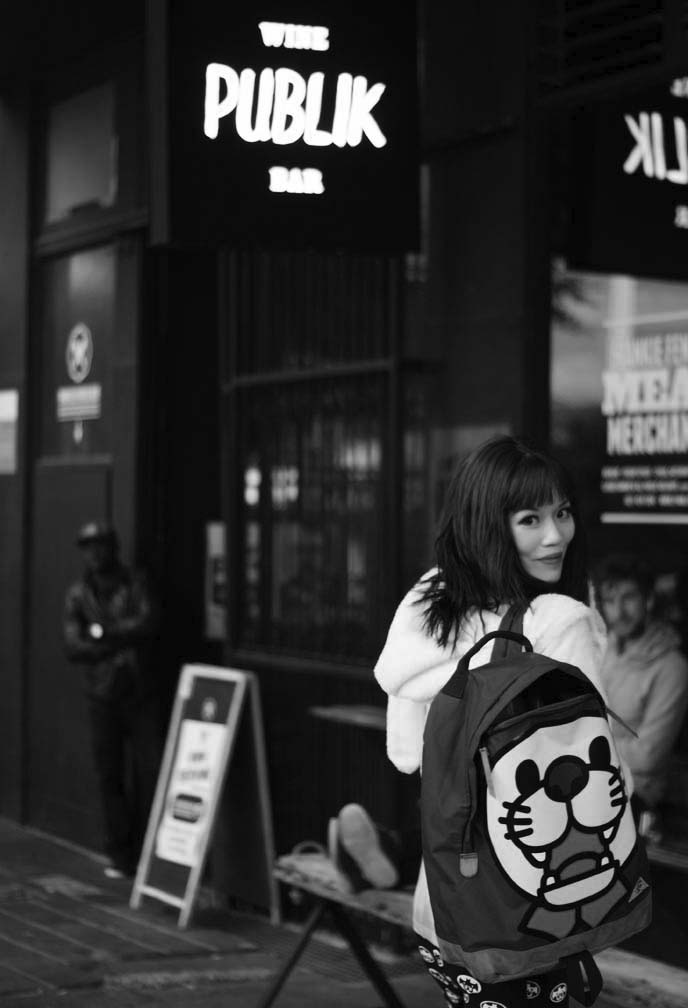
2. Cape Town Wine Bars
Another glass? Yes please. I got tipsy at Publik, a laid-back bar that serves local wines along with cheese, rye with quince, and smoked free-range meats. If you usually dislike a certain varietal, they might surprise you with a delicious version that makes you think twice. The goblets and high counters make this an easygoing experience — there’s no snobbery here.
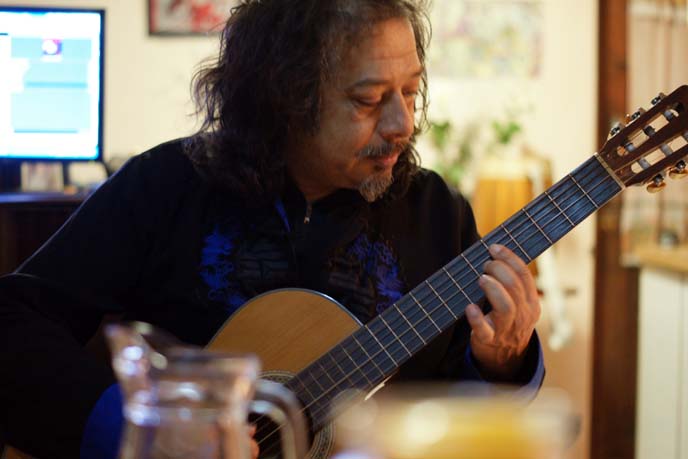
3. Jazz Safari with Local Musicians
I love getting to know locals wherever I go. One night, we joined a Jazz Safari tour that took us inside the homes of local musicians. We ate dinner together, and then listened to a private home performance.
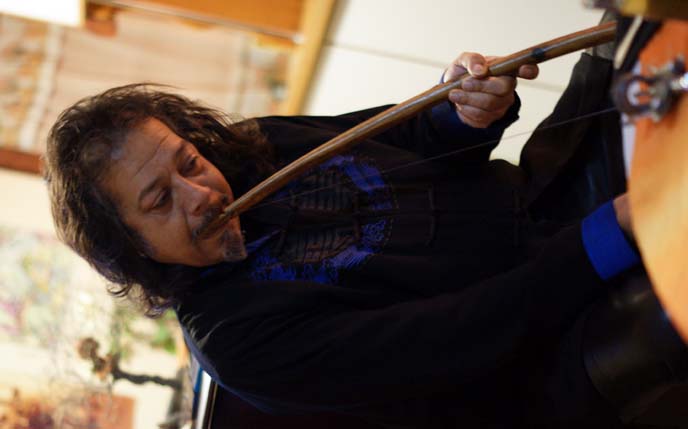
Musician Hilton Schilder’s wife prepared us a hearty curry with rice, and it was one of the best meals I had in Cape Town (along with Faldela Tolker’s Cape Malay cooking). Hilton plays multiple instruments, and performed experimental pieces on piano, guitar and this African mouth bow. I enjoyed hearing about his inspiration, such as how he composed a 15 minute song called “Rebirth” by visualizing a keyboard on the ceiling, as he was lying in bed recovering from an illness.
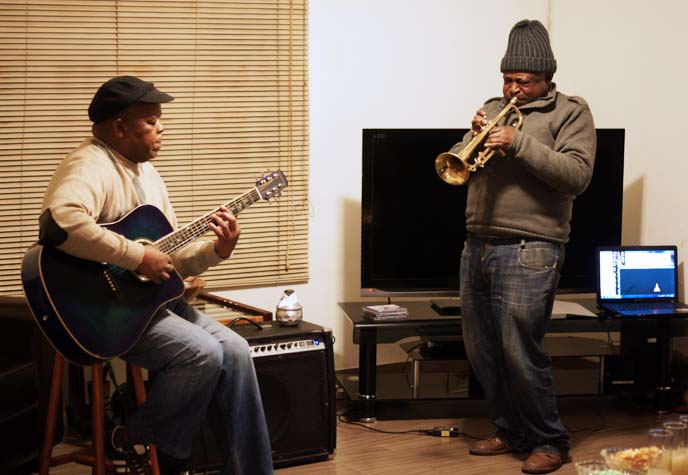
Next, our guide Michael drove us to one of the townships. We saw some metal shacks on the outskirts, but most of the residents lived in small houses. Not nearly as ominous as you might imagine.
TA Blaques performed energetic compositions on trumpet, with his friend on guitar. Cape Jazz is a local style that mixes Western and African influences, with plenty of improv. We tapped our feet along as they played a mix of “Pata Pata” and “In the Jungle.” What a memorable night.
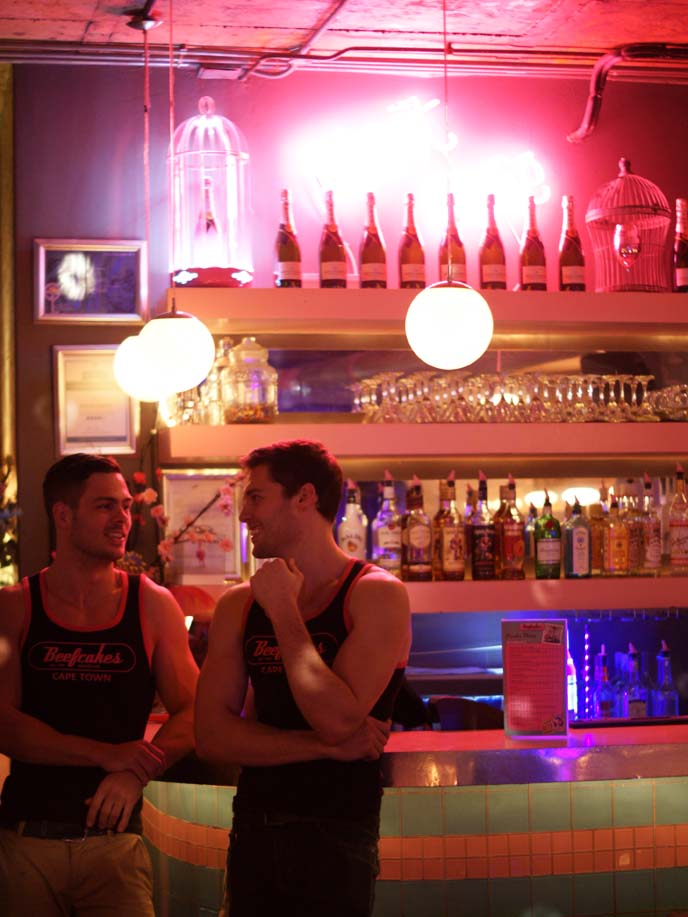
4. Beefcakes Gay Bar & Drag Queen Show
Now, for a very different type of nightlife… What is the gay scene like in Cape Town? I must say, pink and fabulous! The gay bar Beefcakes has a double meaning: it serves burgers, and the waiters are all beefed-up studs!
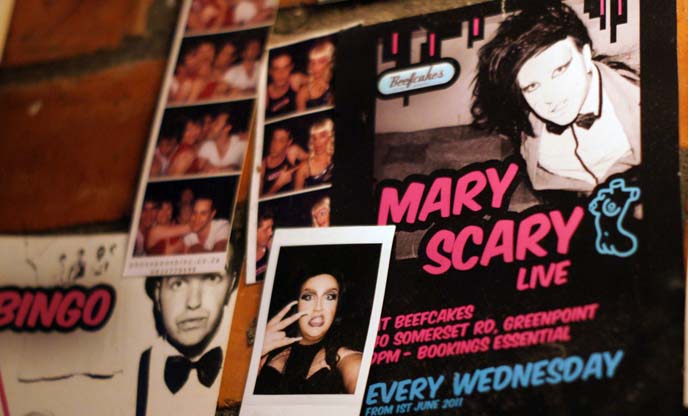
Beefcakes has frequent “boogie nights” that bring in LGBT and alternative performers. The bar is a favorite destination for girls nights too. We saw a bachelorette doing a “body shot” off a waiter’s six pack.
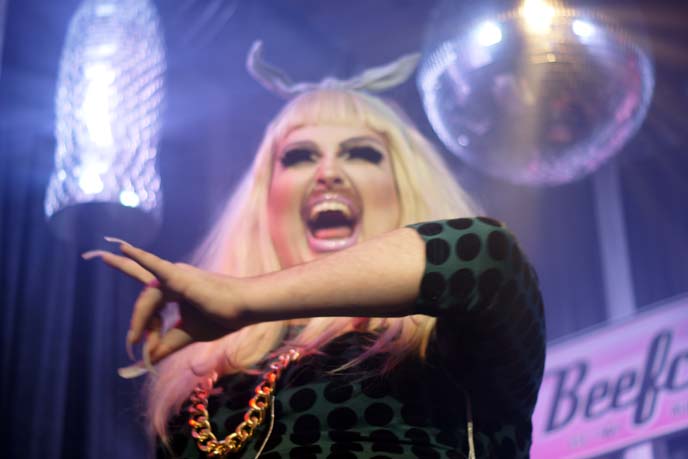
But that evening, all eyes were on drag queen Champagne le Roux. She took the stage, and made snide but light-hearted comments about people in the audience. At one point, my cutesy lion backpack was the subject of her interrogation.
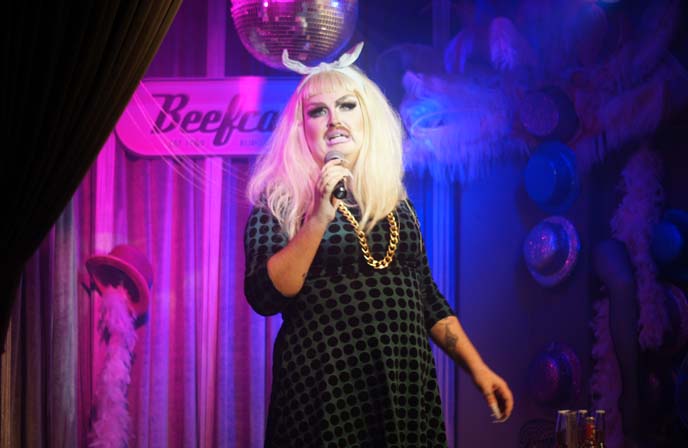
After some song-and-dance numbers, it was time for “Bitchy Bingo.” Champagne ordered a “ball boy” to come on stage and pick out bingo numbers.
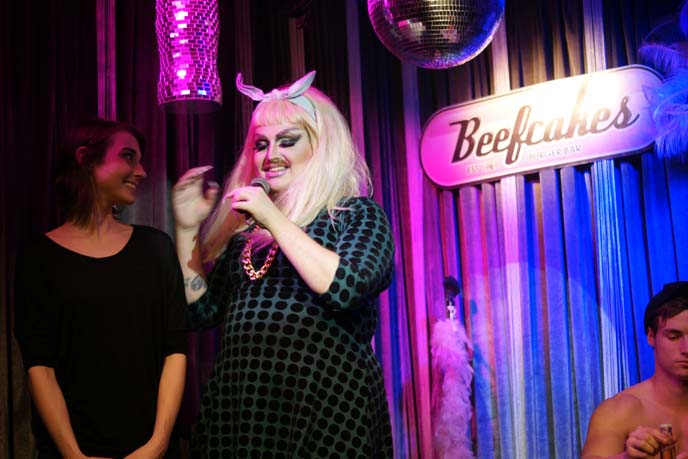
Our friend Vicky won! She had to go onstage to dance with the queen, and then got awarded prizes like a Beefcakes calendar and a bottle of warm beer.
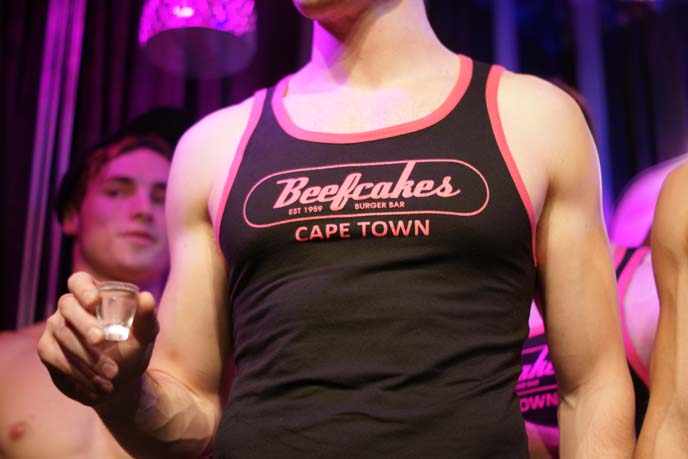
“Macho macho man…” Crazy to think that I’ve seen drag queen shows in so many parts of the world now, from Israel to Tokyo. (Photography by Melissa Rundle, Eric Bergemann and La Carmina.)
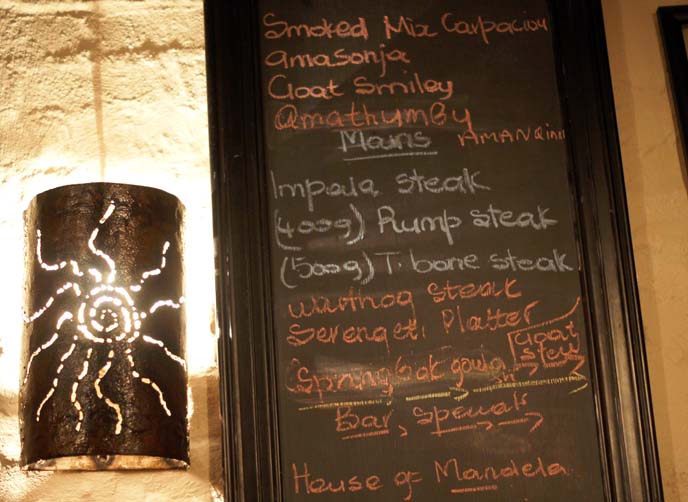
5. African Cuisine
Speaking of meat, Cape Town Tourism organized some outstanding meals for us. At Africa Cafe, I tried pap for the first time — a mushy, gluey staple carb made from ground maize. The menu offered African exotic meats, including springbok, impala, crocodile, and warthog (alas, poor Pumbaa!).
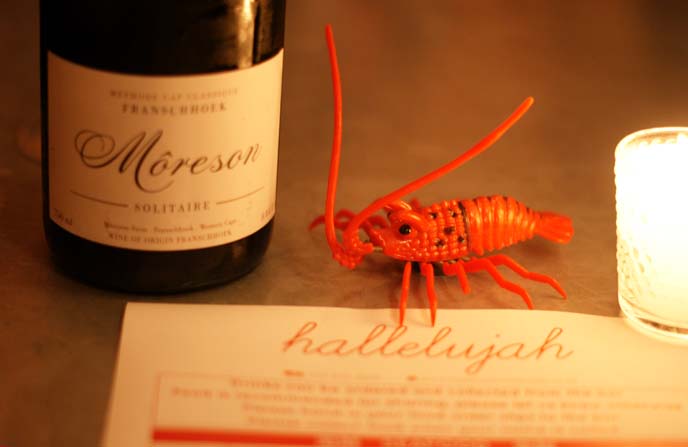
6. Drinking Cap Classique
Alcohol is a big part of my Top 10 list, isn’t it? At Hallelujah, I tasted a selection of Cap Classique “champagne,” a bubbly wine from South Africa. It was apparently a favorite of Marie Antoinette and European royalty.
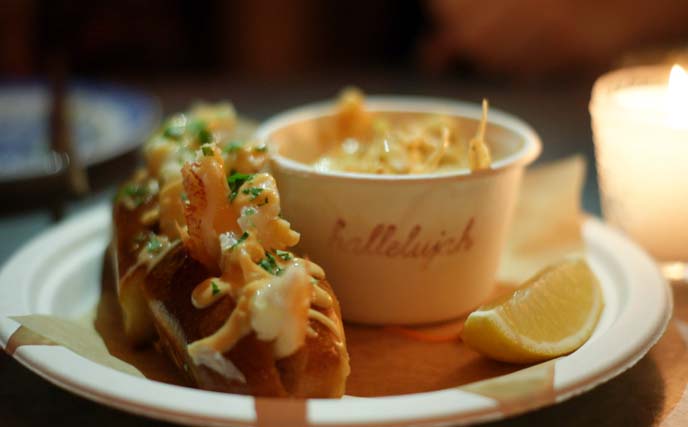
Hallelujah also serves outstanding Asian street food at like prawns with hot steamed buns and coleslaw. Melt-in-your mouth dishes designed for sharing, inspired by dim sum and Asia comfort foods. I didn’t realize Cape Town had such hip restaurants and bars.
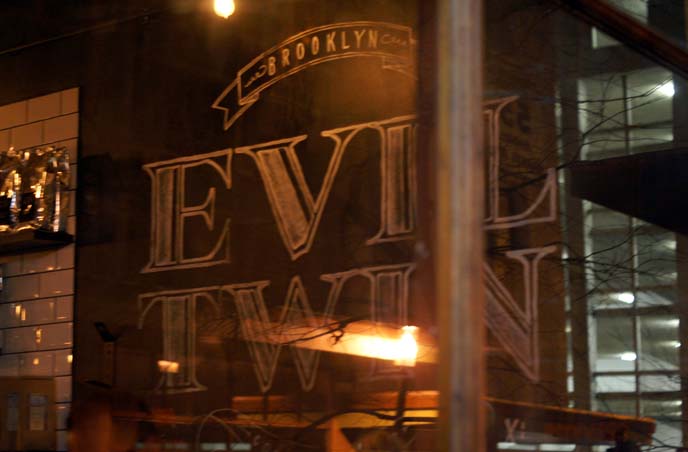
7. The House of Machines
A lot of locals recommended a bar called The House of Machines. Once we got there, we saw what all the buzz was about. This space is a mix of motorcycles, men’s fashion, art and cocktails.
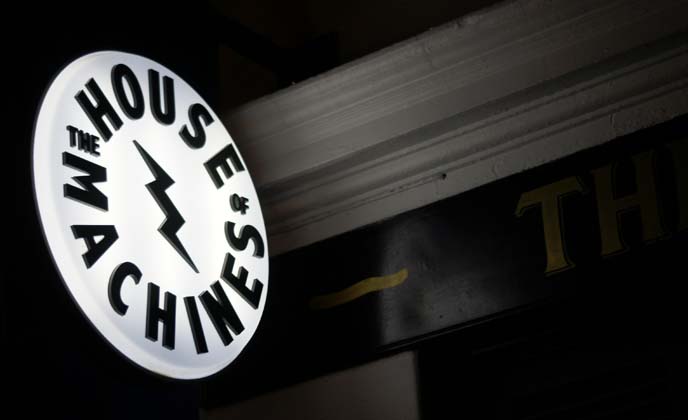
They make a mean dark and stormy cocktail, and the music (indie rock, dance, local) is spot on. The next time I’m in Cape Town, I’ll be heading straight here.
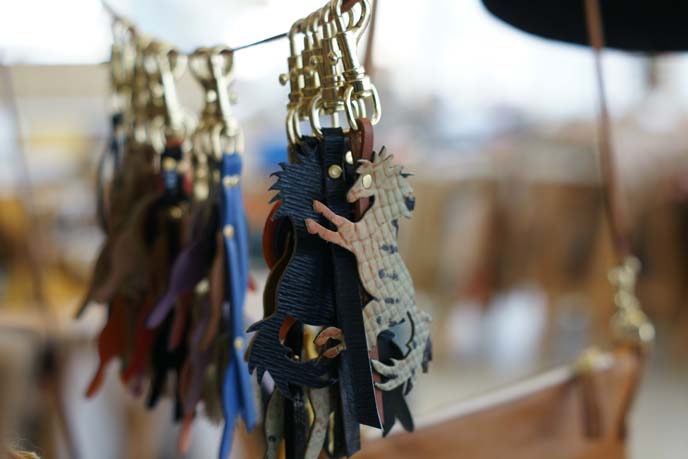
8. Handmade Local Fashion
Missibaba is a women-run leather studio that stays true to its Cape Town origins. Many of the accessories take inspiration from African art, such as purses with tribal patterns.
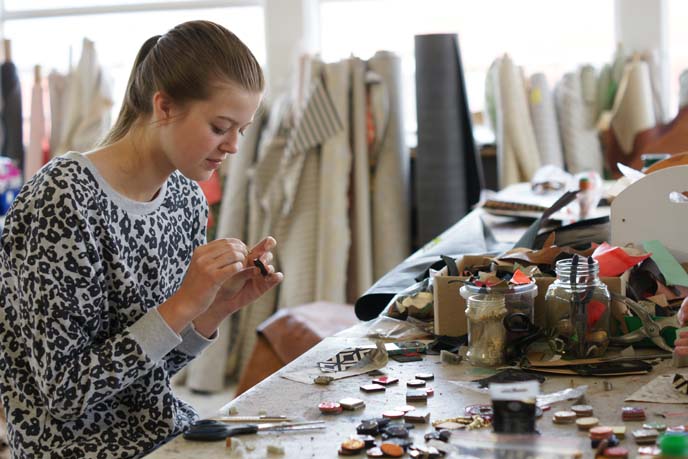
A devotee of “slow fashion,” Missbaba employs local craftswomen who make almost all of the designs by hand.
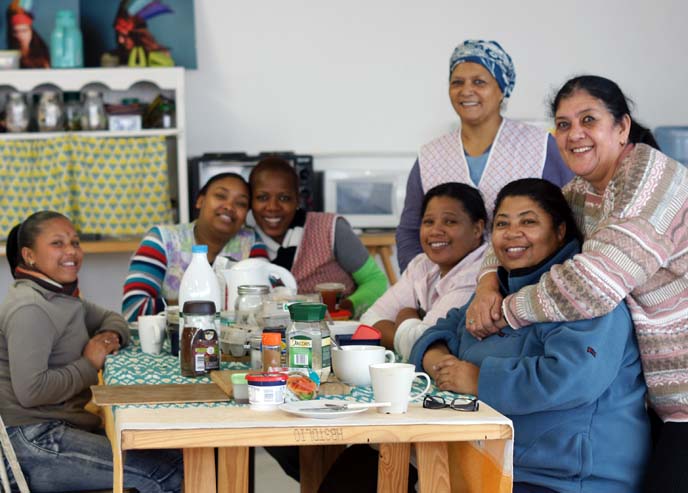
Lead designer Chloe Townsend is passionate about “slow fashion” and supporting South African women. Her workshop employs craftswomen from an underprivileged township, and she donates a portion of proceeds to local empowerment programs.
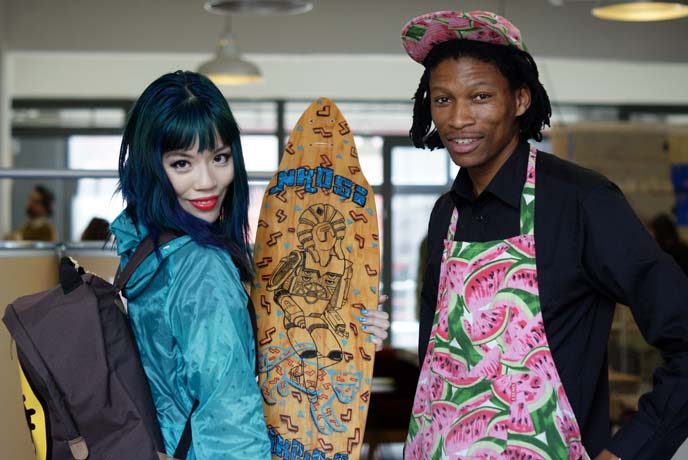
9. Young Design Studios
Remember my trip to Woodstock Exchange, a modern art hub? You can’t leave Cape Town without exploring the cool studios inside.
I interviewed designer Atang Tshikare of Zabalazaa about his urban illustrations, which he custom-creates on skateboards and other surfaces.
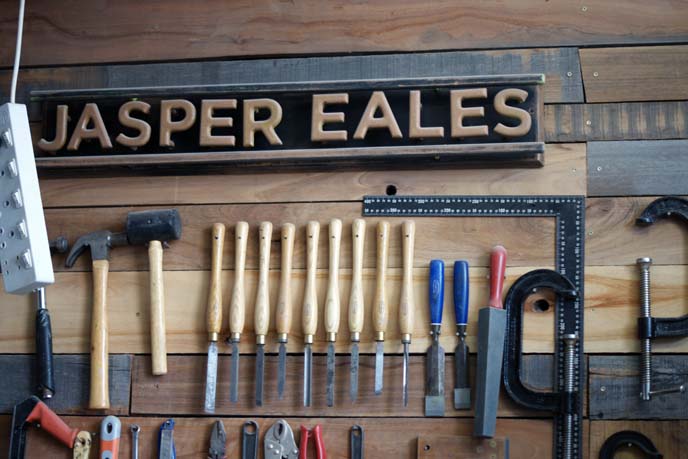
He shares a space with Jasper Eales, a product designer who won awards for his eco-friendly design solutions, like a clever surfboard storage rack.
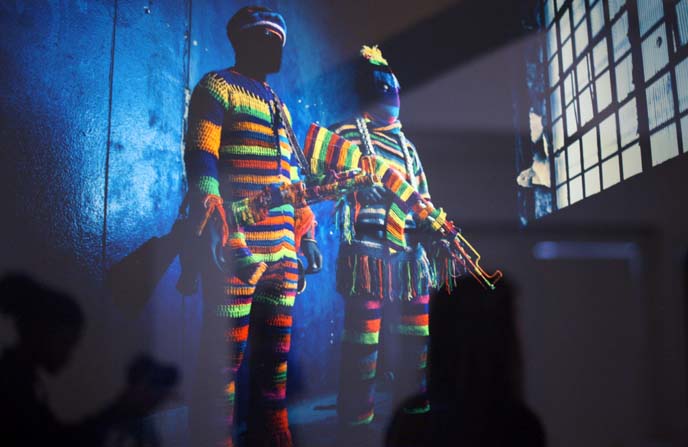
10. Powerful Political Art
Cape Town has a tumultuous history that is often contemplated in its local art. Ralph Ziman’s photos symbolize the devastation caused by arms trading. He photographed street vendors holding AK-47 guns, created out of African beads and wire.
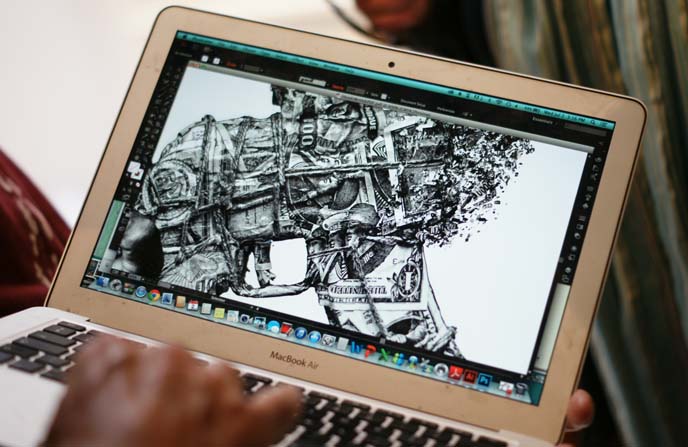
His team showed us “Resistance”, a 100-meter long installation of a broken gun made from wheat paste. The weapon is wrapped in world currencies, symbolizing the international complicity in the arms trade.
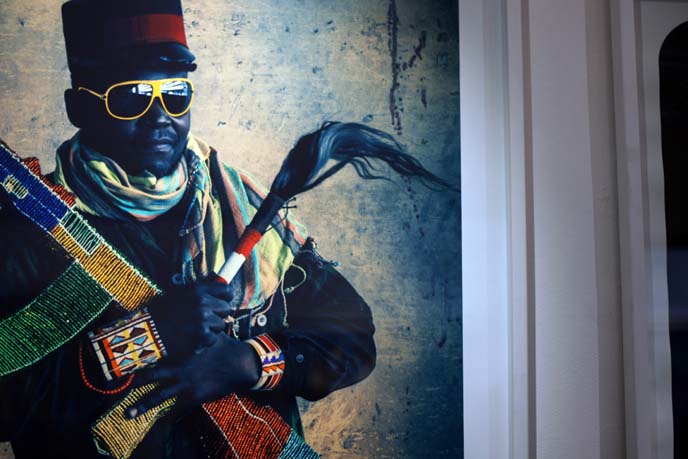
If you’re intrigued by this art scene, take a look at my post about the street art in Woodstock. And don’t forget to view our Cape Town travel video, to see it all in action.

I leave you with this smiling warthog from the vineyard. He seems to be humming Hakuna Matata.
Did this post open your eyes to South Africa’s wines, LGBT nightlife and restaurants? Please let us know your feedback on the video, and where you’d like us to see us travel next!

 LA CARMINA
LA CARMINA






